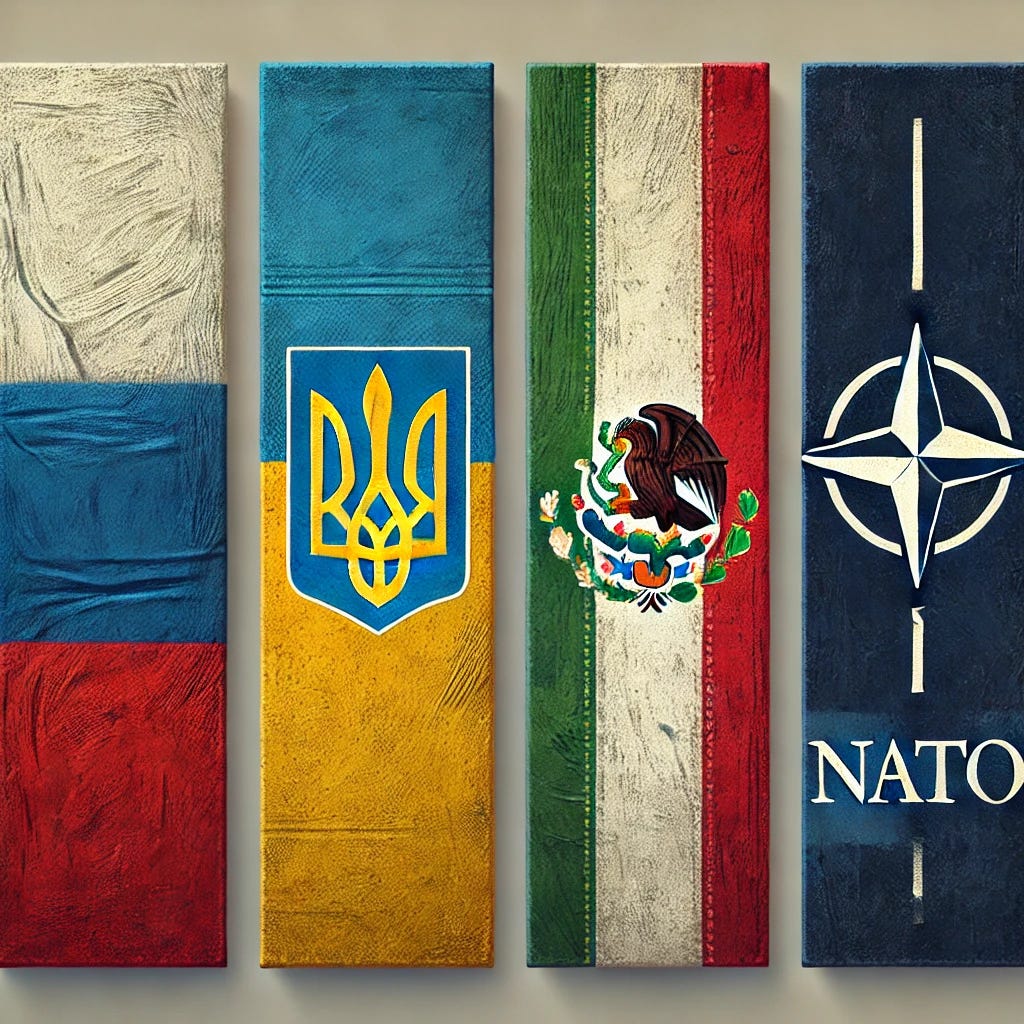Decoding Trump’s Foreign Policy: Part I
What will Trump's foreign policy approach look like in the Russia-Ukraine war, Mexico, and NATO?
Donald Trump’s foreign policy approach will likely echo three key themes from his first term: unilateralism, transactionalism, and economic pressure. This report will be divided into two parts.
The first will focus on Mexico, Ukraine-Russia, and NATO. The second will explore foreign policy approaches and implications for Israel, Iran and China.
Mexico
Trump’s policies towards Mexico are interconnected through a strategy of economic coercion and legal restructuring aimed at addressing illegal immigration. The proposed 25% tariffs on Mexican imports are not merely a trade measure; they are a tool of leverage.
Trump argues that Mexico must act decisively to stop migrants from crossing into the United States, asserting that tariffs will force Mexico to help stop the mass influx of illegal immigrants into the country.
By tying economic penalties to border enforcement, he aims to pressure Mexico into assuming greater responsibility for controlling migration flows. The Remain in Mexico policy fits into this framework by effectively externalizing the U.S. immigration burden.
Under this policy, asylum seekers would be required to stay in Mexico while their claims are processed, creating a disincentive for unauthorized crossings. Trump contends that this approach reduces the appeal of illegal immigration by ending the catch and release policy.
Together, these initiatives create a layered approach. Tariffs serve as a stick to compel Mexican compliance, while the Remain in Mexico policy ensures that asylum seekers are managed outside U.S. borders.
This strategy shifts the logistical and economic costs of migration onto its southern neighbor, reinforcing Trump’s broader goal of making Mexico a gatekeeper against illegal immigration.
Trump has labeled the cartels national security threats and suggested designating them as foreign terrorist organizations (FTOs), a classification that would open new legal avenues for military engagement. Under U.S. law, such a designation would enable the use of broader tools, including:
Freezing of cartel assets;
Imposing sanctions on individuals and entities providing material support;
Authorizing expanded military involvement under national security statutes;
It would also allow U.S. intelligence agencies to prioritize cartels with resources typically reserved for counter-terrorism operations.
Trump’s plan includes precision strikes on cartel infrastructure, targeted operations to eliminate high-value individuals, and expanded surveillance and intelligence-sharing capabilities. This approach represents a shift from traditional counter-narcotics policies, which have relied on bilateral cooperation and capacity-building within Mexican institutions.
Instead, Trump proposes direct intervention, a move that not only reflects his broader preference for unilateral action but also seeks to bypass perceived inefficiencies in Mexico’s security apparatus.
He has argued that this approach, similar to counter-terrorism operations in the Middle East, would dismantle the supply chains fueling the opioid epidemic.
Operationally, this initiative would face immense logistical and legal hurdles. A cross-border military campaign would require Congressional authorization unless justified under immediate national security threats.
Republicans dominating the executive and legislative branches could mean expedited approval. But this is not a given. Republican control of both the executive and legislative branches during the first two years of Trump's term suggested smoother policymaking, but they still faced significant challenges in advancing key policies.
Additionally, the scale of operations necessary to dismantle deeply entrenched cartel networks would likely exceed initial estimates, requiring sustained engagement and resources. Prolonged U.S. military involvement in Mexico without a clear exit strategy would conflict with the strategic focus on Southeast Asia
Designating cartels as foreign terrorist organizations amplifies risks for firms engaged in financial or trade activities. Banks and exporters would face stricter compliance requirements, with the threat of penalties for inadvertent links to cartel-affiliated entities.
For retailers, manufacturers, and the automotive industry, where Mexico accounts for nearly 40% of all vehicle parts imported into the United States, a 25% tariff could increase average vehicle prices by $2,000 to $3,000 per car.
In agriculture, nearly $14 billion worth of fresh produce, including avocados, tomatoes, and berries, is imported annually from Mexico. A 25% tariff on these goods could lead to price increases of 10-20% in U.S. grocery stores.
Geopolitically, these policies could lead to a nationalist backlash and weaken Mexico’s political alignment with the U.S. But not enough to steer Mexico into China’s orbit. Mexico’s President Claudia Sheinbaum has a daunting task ahead of her, and will need to balance multiple priorities with Mr. Trump.
Russia-Ukraine
President Volodymyr Zelensky has underscored the urgency of achieving a diplomatic resolution to the war with Russia in the coming year, as the geopolitical landscape shifts following Donald Trump’s U.S. presidential election victory.
This statement comes amid accelerating Russian advances on the battlefield, particularly in the eastern regions of Donetsk and Luhansk, as well as Kherson and Zaporizhzhia in the south.
These territories, which together make up nearly 20% of Ukraine’s internationally recognized landmass, remain under Russian control and serve as focal points for Moscow’s efforts to consolidate its position.
Ukrainian officials maintain that their objective is to reclaim all occupied territories. This goal is widely supported by the Ukrainian public, but attitudes are beginning to shift as the reality of the conflict grinds on.
Acceptance of potential territorial concessions is growing, reflecting both the immense toll of Russia’s slow but steady advances on the eastern front and the staggering losses sustained by both sides.
Donald Trump’s proposed peace plan introduces a new dimension to these developments. His strategy includes establishing a demilitarized zone along the current front lines, with European troops potentially patrolling the buffer area to maintain separation between Russian and Ukrainian forces.
A central feature of the plan is a 20-year moratorium on Ukraine’s NATO membership aspirations, effectively delaying its integration into the alliance. Despite these concessions, Trump’s plan commits to continued U.S. military aid to Ukraine to deter further aggression.
However, the plan notably excludes the deployment of American troops to enforce the peace, aligning with Trump’s broader policy of limiting direct U.S. military involvement.
On the U.S. side, just yesterday, President Joe Biden has approved the use of American-supplied long-range missiles by Ukraine for strikes on Russian territory, a marked departure from earlier restrictions.
This decision escalates the stakes, occurring just weeks before Trump assumes office and potentially altering the calculus for all involved.
The territories of Donetsk, Luhansk, Kherson, and Zaporizhzhia are not just battlegrounds but also critical to any diplomatic resolution. Russia’s occupation of these regions solidifies its negotiating power, while Ukraine’s determination to reclaim them reflects a broader struggle for sovereignty and national identity.
Trump’s proposed plan, balancing territorial freezes and NATO concessions with continued military support, reflects an attempt to reset the conflict’s trajectory.
Trump’s plan to call for a demilitarized zone along the front lines and a 20-year moratorium on Ukraine’s NATO membership aligns with Russia’s longstanding security demands. While this approach may lower immediate tensions, it risks reinforcing a precedent that territorial aggression yields concessions.
European involvement in patrolling the demilitarized zone could reframe the conflict as a regional European security issue rather than a broader transatlantic challenge.
This shift might reduce the United States’ direct military role but increase pressure on European nations to shoulder greater security responsibilities. While this aligns with Trump’s vision of burden-sharing, it could test the capacity of European militaries to manage a prolonged and resource-intensive peacekeeping mission.
Failure to maintain stability in the buffer zone would risk reigniting hostilities, destabilizing Europe’s eastern flank. For Ukraine, the plan offers continued U.S. military aid but imposes significant strategic limitations, particularly on NATO ambitions.
NATO
Donald Trump’s approach to NATO centers on redefining the alliance’s financial and operational structure to prioritize burden-sharing among member states.
During his previous administration, Trump consistently criticized NATO members for failing to meet the defense spending target of 2% of GDP, arguing that the U.S. disproportionately funds the alliance.
This focus on financial equity is likely to remain central, with Trump pushing for stricter enforcement mechanisms to ensure compliance, potentially conditioning U.S. commitments on member states’ contributions.
Strategically, Trump’s approach to NATO is expected to emphasize recalibrating the alliance’s priorities to align more closely with U.S. national interests.
This could involve a shift away from focusing on collective European defense against Russia and toward broader concerns like counterterrorism and managing China’s rising influence.
Trump has previously questioned NATO’s relevance in addressing 21st-century threats, suggesting the alliance must adapt or risk becoming obsolete. Such rhetoric might lead to pressure for operational reforms or a reallocation of NATO resources.
If Trump deprioritizes NATO or conditions U.S. involvement, European members may take greater steps toward defense autonomy.
Initiatives like the European Union’s Permanent Structured Cooperation (PESCO) and increased investment in European defense could gain momentum, potentially creating a parallel security structure. European defense contracting stocks would likely benefit from this trajectory.
While this might alleviate U.S. financial burdens, it risks diluting NATO’s cohesion and reducing U.S. influence over European security policy. The US may shoulder the financial burden, but the benefits include asymmetric leverage in a region’s security policy.





Trump's foreign policy underscores the need for Europe to adapt to a world where transatlantic guarantees may no longer suffice or be assured. It's time for EU member states to assume greater responsibility for their own security, whether in alignment with NATO or facing the Phantomschmerz of its potential absence.